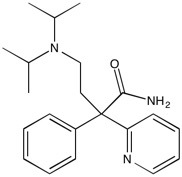Disopyramide | Antiarrhythmic
NMR (Conforms)

Available Options
| Size : | Price | Quantity | |
|---|---|---|---|
| 50 mg | $35.00 | ||
| 250 mg | $95.00 |
Disopyramide (3737-09-5) is a clinically useful sodium channel blocker used as an antiarrhythmic for treatment of ventricular tachycardia1 and hypertrophic cardiomyopathy2. It decreases the rate of diastolic depolarization, decreases the upstroke velocity and increases the action potential duration of normal cardiac cells. It decreases the disparity between infarcted and normal myocardium refractory periods. Disopyramide has no effect on α or β-adrenergic receptors but does display significant anticholinergic effects.3
References/Citations:
1) Heel et al. (1978), Disopyramide: a review of its pharmacological properties and therapeutic use in treating cardiac arrhythmias; Drugs 115 331
2) Verlinden et al. (2015), Disopyramide for Hypertrophic Cardiomyopathy: A Pragmatic Reappraisal of an Old Drug; Pharmacotherapy, 35 1164
3) Nakajima et al. (1989), Anti-Cholinergic Effects of Quinidine, Disopyramide, and Procainamide in Isolated Atrial Myocytes: Mediation by Different Molecular Mechanisms; Circ. Res., 64 297
NMR (Conforms)
Safety Data Sheet:
Product Data Sheet:
Materials provided by Focus Biomolecules are for laboratory research use only and are not intended for human or veterinary applications. Please note that we do not sell to individuals and that all orders placed by non-research organizations will incur a $20 restocking/refund fee
Disopyramide (3737-09-5) is a clinically useful sodium channel blocker used as an antiarrhythmic for treatment of ventricular tachycardia1 and hypertrophic cardiomyopathy2. It decreases the rate of diastolic depolarization, decreases the upstroke velocity and increases the action potential duration of normal cardiac cells. It decreases the disparity between infarcted and normal myocardium refractory periods. Disopyramide has no effect on α or β-adrenergic receptors but does display significant anticholinergic effects.3
References/Citations:
1) Heel et al. (1978), Disopyramide: a review of its pharmacological properties and therapeutic use in treating cardiac arrhythmias; Drugs 115 331
2) Verlinden et al. (2015), Disopyramide for Hypertrophic Cardiomyopathy: A Pragmatic Reappraisal of an Old Drug; Pharmacotherapy, 35 1164
3) Nakajima et al. (1989), Anti-Cholinergic Effects of Quinidine, Disopyramide, and Procainamide in Isolated Atrial Myocytes: Mediation by Different Molecular Mechanisms; Circ. Res., 64 297
Calculate the molar concentration, mass or volume in a solution.
Concentration × Volume × Molecular Weight = Mass
Focus Biomolecules • Plymouth Meeting, PA USA • 1-855-FOCUS21
Focus Biomolecules
Plymouth Meeting, PA USA
1-855-FOCUS21
Website Created by Advanta Advertising LLC.

